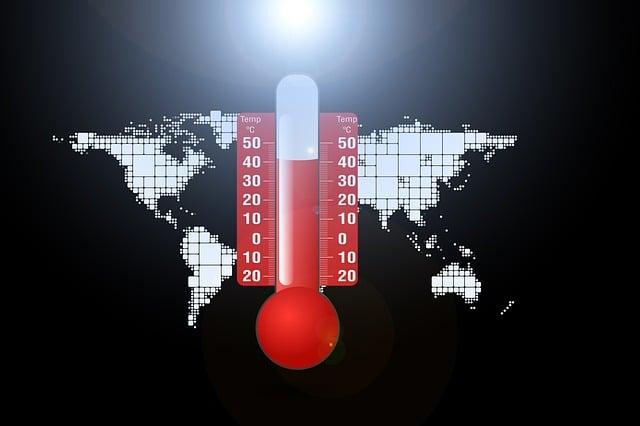- Introduction
- Global Context: A Warming World
- September 2025 Climate Data at a Glance
- Impacts of September’s Record Heat
- The Scientific Explanation Behind the Heat
- Conclusion
- FAQs
- References
Introduction
September 2025 has officially ranked among the hottest months ever recorded, underscoring the persistent trend of global warming. In this article, we analyze the global implications of this record heat, examine local and international climate data, and explore the broader environmental and societal impacts.
We begin by putting this event in the global context of climate change, then review accurate data collected from September 2025. We’ll cover heat-related consequences around the globe and delve into the science explaining these patterns. Finally, we wrap up with key conclusions, answer common questions, and provide links to reliable sources.
Global Context: A Warming World

(Image: Pixabay/@geralt)
In recent decades, the world has witnessed unrelenting increases in average global temperatures. The month of September, traditionally a transitional period from summer to fall in many parts of the world, has consistently trended warmer. September 2025 stands out as one of the most extreme months in this trajectory.
Since the turn of the century, every major climate organization — including NOAA, NASA, and the World Meteorological Organization — has confirmed that each decade surpasses the one before it in terms of heat. This is largely attributed to greenhouse gas emissions, increased deforestation, and the continuous burning of fossil fuels.
Extreme weather events, vanishing glaciers, and rising sea levels all represent tangible evidence of a warming planet. September 2025 adds another data point to an alarming pattern. These consistent changes aren't merely statistical; they are transforming ecosystems and challenging ways of life worldwide.
September 2025 Climate Data at a Glance

(Image: Pixabay/@Tama66)
Early data released by global meteorological stations indicates that the average global temperature in September 2025 exceeded 1.6°C above the pre-industrial baseline. Europe, parts of Africa, East Asia, and the southern United States experienced record-high daytime and minimum nighttime temperatures.
Satellite imagery also confirms widespread reduction in Arctic sea ice, correlating with the warmed air and ocean surface temperatures. Meteorologists observed higher-than-average sea surface temperatures in the Pacific and Atlantic Oceans, suggesting the amplifying effect of phenomena such as El Niño may be in play.
According to NOAA’s Global Climate Report, September 2025 was the fourth consecutive month in a streak of record-breaking global heat spanning the latter half of the year. This situates it among the top three hottest Septembers in recorded history — a troubling benchmark as climate records continue to fall year after year.
Impacts of September’s Record Heat

(Image: Pixabay/@Mindworld)
The impacts of September 2025's intense heat have been widespread and multifaceted. From severe droughts in Sub-Saharan Africa to wildfires across southern Europe and Canada, communities are facing the consequences of prolonged high temperatures and dry conditions.
In urbanized areas, extreme heat increased electricity demand due to air conditioning use, straining energy grids and inflating utility costs. Vulnerable populations — including the elderly and young children — were especially susceptible to heat-related illnesses, resulting in a rise in hospitalizations reported in several regions.
Agricultural sectors saw disruptions as well. Crop yields declined in multiple countries due to heat stress and altered rainfall patterns. Fish populations also shifted in response to changing sea temperatures, impacting coastal economies reliant on fishing industries.
The Scientific Explanation Behind the Heat

(Image: Pixabay/@geralt)
Climate scientists emphasize that September 2025's extreme temperatures are not isolated anomalies but the outcomes of long-term changes driven by human activities. Greenhouse gases — notably carbon dioxide and methane — continue to trap heat within Earth’s atmosphere, raising global temperatures year over year.
This year, researchers point to a moderate El Niño event, which typically raises ocean surface temperatures and contributes to atmospheric heating. Combined with widespread deforestation and urbanization, these natural and human-induced factors combined to push September temperatures to alarming heights.
Recent studies using climate models suggest that unless emissions are drastically reduced, such record-breaking temperatures may become commonplace within the next two decades. Scientists call for accelerated climate action, highlighting renewable energy transitions, conservation efforts, and adaptation strategies as essential responses to this trend.
Conclusion
September 2025 serves as a stark reminder that climate change is not a distant threat but an ongoing reality. With new temperature records being set almost monthly, what was once considered "extreme" weather is fast becoming the new normal. Immediate and sustained efforts are required from governments, industries, and individuals to halt and reverse the current warming trajectory.
Beyond statistics, the impacts of global warming pose real-life challenges for people and ecosystems. Taking action today can help lessen the risks for future generations and preserve the stability of our planet.
FAQs
How hot was September 2025 compared to previous years?
September 2025 was approximately 1.6°C warmer than the pre-industrial average and ranks among the top three hottest Septembers ever recorded globally.
Did El Niño contribute to the high temperatures?
Yes, a moderate El Niño phase likely amplified ocean and atmosphere heating, contributing to higher-than-usual temperatures in many regions.
What areas were most affected by the heat?
Regions including Southern Europe, Central Africa, Southeast Asia, and parts of North America reported the most significant temperature anomalies and environmental impacts.
Is global warming accelerating?
Climate data suggests that the rate of global warming has accelerated in recent decades due to increased greenhouse gas emissions and feedback mechanisms like melting ice caps and forest loss.
What steps can be taken to mitigate future heat records?
Mitigation includes reducing carbon emissions, transitioning to renewable energy, reforesting lands, enhancing public transport, building climate-resilient infrastructure, and supporting policy changes on both national and international levels.

